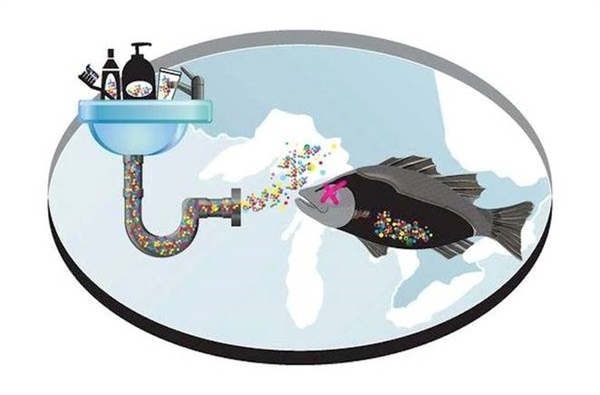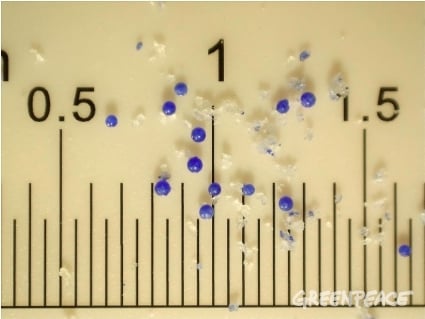
When you google “microbeads,” calls to ban them pop up in the search results even before the trusty Wikipedia definition. That’s because scientific studies and environmental organizations have shone a spotlight on how these tiny, seemingly harmless plastic particles are actually wreaking havoc on marine and freshwater ecosystems. With growing public awareness, accompanied by shock, concern and calls to action, governments are starting to listen. And Canada’s federal government is the latest to declare a timeline for a widespread ban. YAY!
Following the listing of microbeads as a toxic substance under the Environmental Protection Act (EPA) earlier this year, the federal government just announced that the sale of shower gels, toothpaste and facial products containing plastic will no longer be allowed as of July 2018, while natural health and non-prescription drugs containing microbeads will be banned as of July 2019. Perhaps not as speedy as we’d like, but a strong step nonetheless to start to curb the tonnes of plastic entering our aquatic ecosystems every year.
Depending on your brand of choice, what you use to wash your face or brush your teeth could be contributing to billions of little bits of plastic being washed down the drain and out into our waterways. Manufacturers of personal care and toiletry products sometimes include tiny (<5mm) plastic particles for abrasion and exfoliation purposes. These plastic particles, known as microbeads, are made of petrochemicals such as polyethylene, polypropylene or polystyrene. Weird, right?

So, not only are many people unknowingly putting plastic in all of their crevasses and/or in their mouth, but because microbeads are too small to be filtered out by regular water treatment plants, they are travelling out into aquatic environments where they are doing enormous damage to numerous species large and small.
Microbeads are ingested by wildlife and they also absorb other toxins present in aquatic environments. The combination means animals eating poison pills, which get eaten by other animals, and other animals, and other animals resulting in an increasing toxic load being passed up the food chain. And some of species in the foodchains end up on people’s dinner plates.
Greenpeace recently released a report that lays out the science on the impact of microplastics, including microbeads, on our oceans and our seafood. The findings will make your stomach turn. Meanwhile on the freshwater front, research conducted by the 5 Gyres Institute found concentrations averaging 466,000 beads per square kilometre near cities in the Great Lakes, an average of 43,000 beads per square kilometre in the Great Lakes, presenting a significant opportunity for interaction with wildlife. By now we’ve all likely seen the image of the dead bird with a stomach full of plastic, and sadly that’s not even the half of it.
But there is encouraging news amid depressing study results and statistics (like that ~90% of seabirds have ingested plastic). Various levels of governments are starting to listen when people say we must start to tackle plastic pollution. The U.S. Congress approved a ban on microbeads in toiletries that goes into effect July 1, 2017, while a growing number of states have already passed laws banning beads from personal care products. The UK has banned microbeads in personal beauty products effective end of 2017. Korea just announced a ban on microplastics in cosmetics imports effective July 2017 and at point of sale July 2018. Taiwan has banned microbeads from personal care products to go into force at the end of 2018. And Australia has proposed moving forward with a ban if companies do not adhere to a voluntary phase-out by July 2017. Obviously there is more work to do to ensure microplastics are not present in any products, but momentum is definitely building!
And industry has started to take its own steps in response to public pressure and the looming threat of a ban. In Canada, the Canadian Cosmetic Toiletry and Fragrance Association notes that Canadian manufacturers responsible for creating 99 per cent of plastic microbeads have committed to a voluntary phase-out by or before the federal ban goes into effect, and major retailers like Loblaw Companies Ltd. have committed to stop making products with microbeads by 2018. Australian supermarket chains have committed to banning microbeads from their house brand personal care products by the end of 2017.Greenpeace has also ranked various companies and brands, and many companies in markets around the world have jumped on the phase-out bandwagon.
Microbeads are only one part of the plastic pollution problem facing life in our oceans, lakes and rivers. Microplastics, which are actually any kind of tiny plastic pieces including broken-down plastics, byproducts from industrial processes and microfibers go beyond microbeads and in order to stop the creation and flow of these misery bits into our aquatic environments we need to address plastic production of all sizes and at all production levels.
Greenpeace is campaigning to end plastic pollution in our oceans by preventing the problem at its source. Join us!
